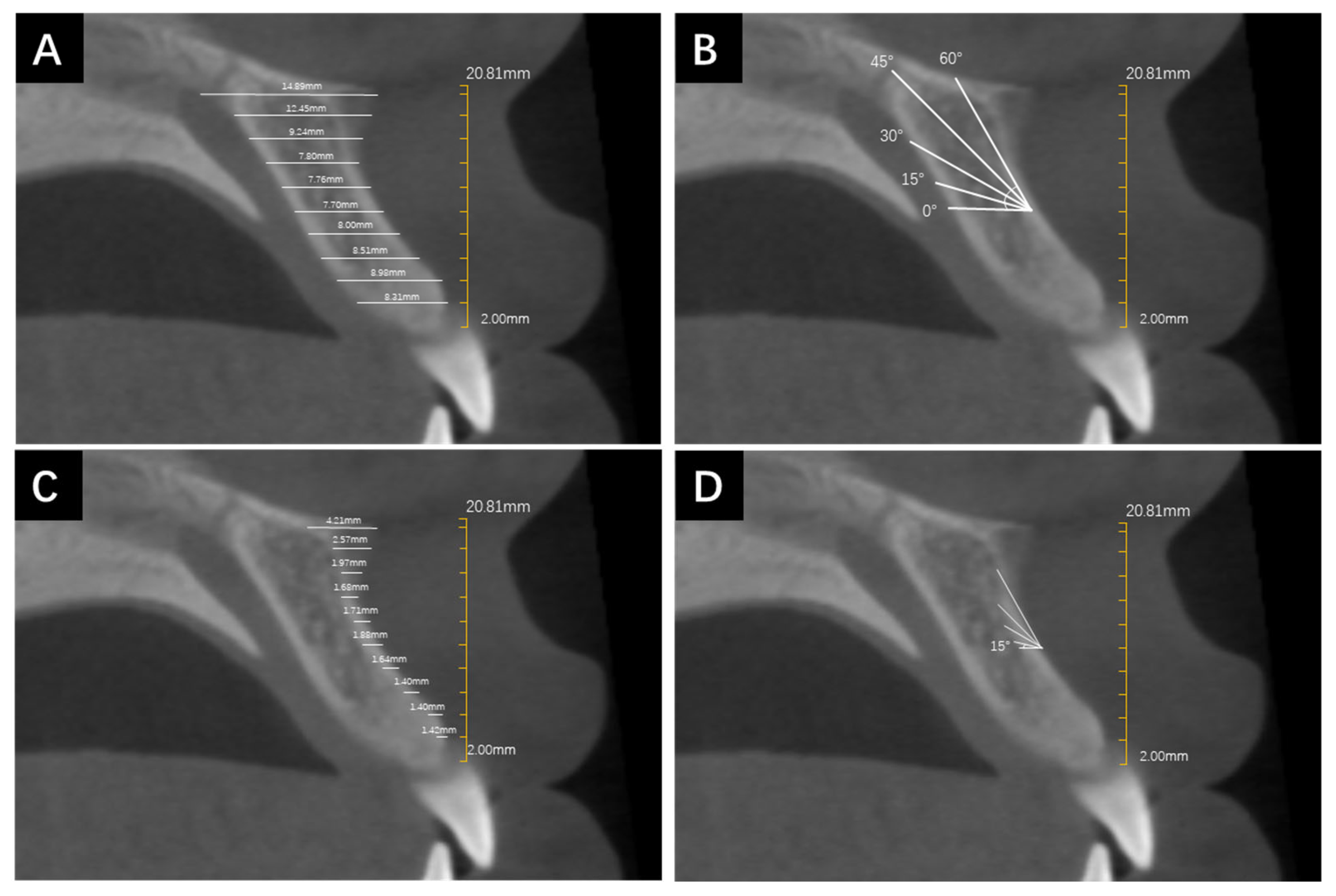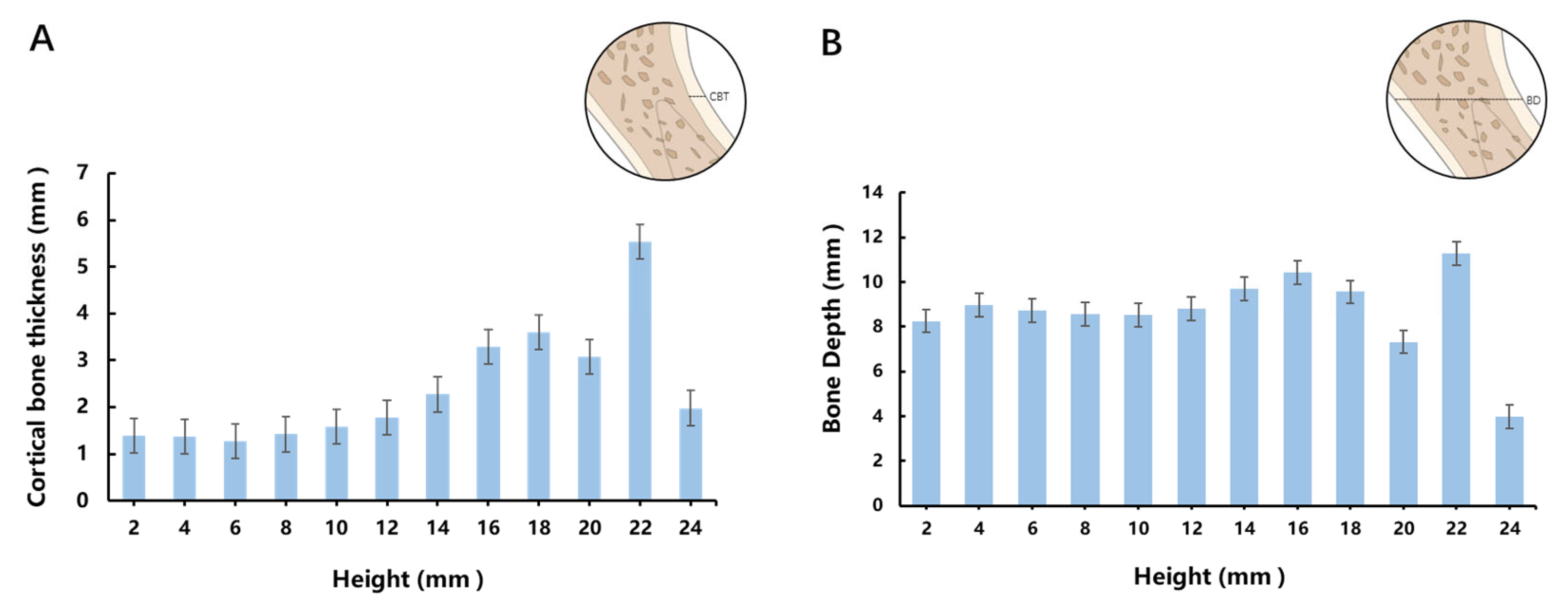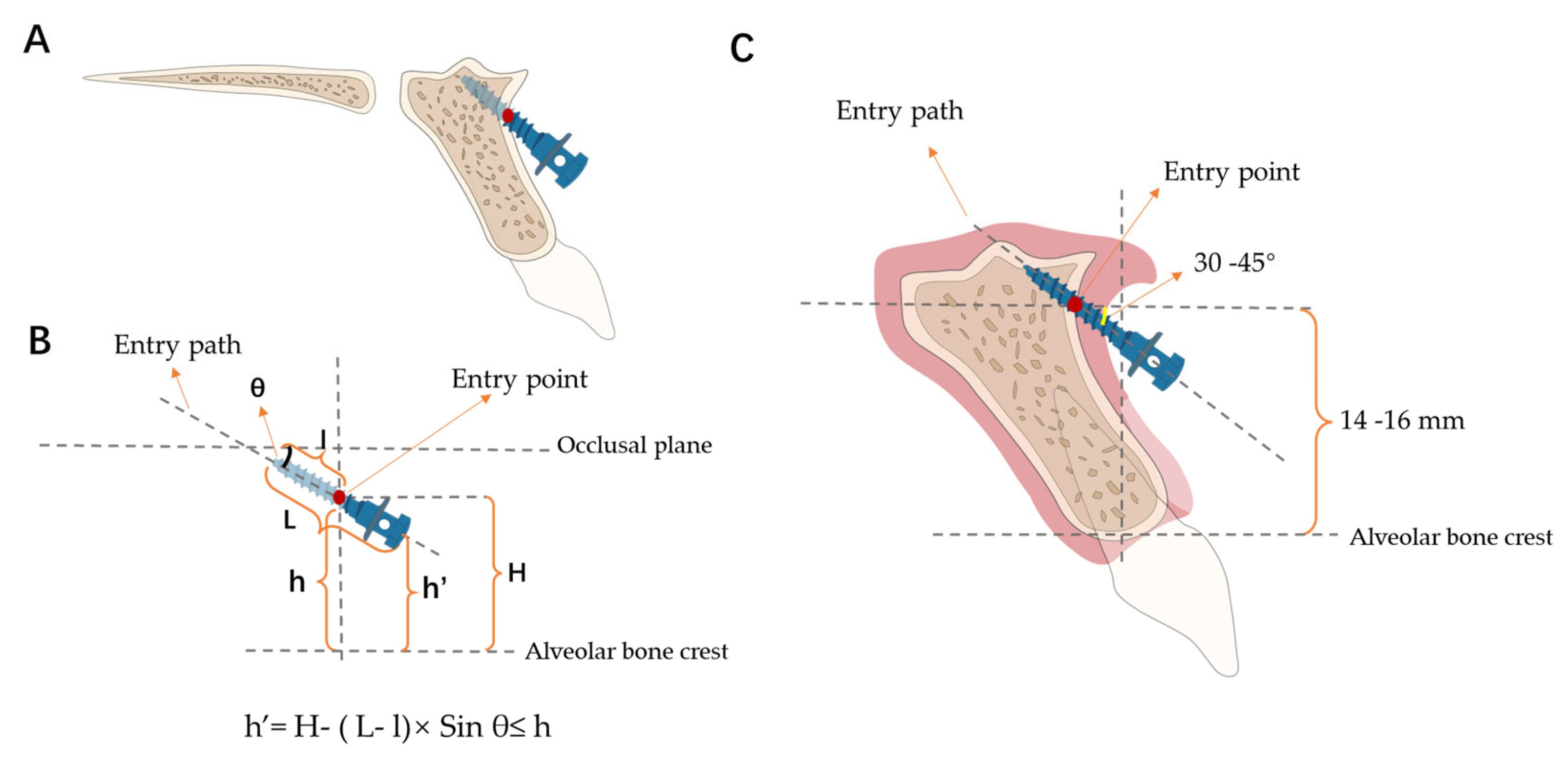Evaluation of Optimal Insertion Sites and Angles for Orthodontic Mini-Implants at the Anterior Nasal Spine Region Based on Cone-Beam Computed Tomography
Abstract
1. Introduction
2. Materials and Methods
2.1. Samples
2.2. CBCT Examinations
2.3. Measurement Protocol
2.4. Statistical Analysis
3. Results
3.1. Patients Profile and Consistency
3.2. Determine ANS Start
3.3. The Relationship between CBT and BD with Respect to Height Variations at 0°, 15°, 30°, 45°, and 60° Insertion Angles
3.4. The Relevance between Alveolar Bone Parameters and Sex, Age, and Growth Pattern
4. Discussion
5. Conclusions
Author Contributions
Funding
Institutional Review Board Statement
Informed Consent Statement
Data Availability Statement
Conflicts of Interest
References
- Parayaruthottam, P.; Antony, V. Midline Mini-Implant-Assisted True Intrusion of Maxillary Anterior Teeth for Improved Smile Esthetics in Gummy Smile. Contemp. Clin. Dent. 2021, 12, 332–335. [Google Scholar] [CrossRef] [PubMed]
- Reddy, S.; Jonnalagadda, V.N.S. Mini-Implant Assisted Gummy Smile and Deep Bite Correction. Contemp. Clin. Dent. 2021, 12, 199–204. [Google Scholar] [CrossRef] [PubMed]
- Ohnishi, H.; Yagi, T.; Yasuda, Y.; Takada, K. A mini-implant for orthodontic anchorage in a deep overbite case. Angle Orthod. 2005, 75, 444–452. [Google Scholar] [CrossRef] [PubMed]
- Buczkowska-Radlinska, J.; Szyszka-Sommerfeld, L.; Wozniak, K. Anterior tooth crowding and prevalence of dental caries in children in Szczecin, Poland. Community Dent. Health 2012, 29, 168–172. [Google Scholar] [PubMed]
- Lux, C.J.; Dücker, B.; Pritsch, M.; Niekusch, U.; Komposch, G. Space conditions and prevalence of anterior spacing and crowding among nine-year-old schoolchildren. J. Orthod. 2008, 35, 33–42. [Google Scholar] [CrossRef]
- Lombardo, G.; Vena, F.; Negri, P.; Pagano, S.; Barilotti, C.; Paglia, L.; Colombo, S.; Orso, M.; Cianetti, S. Worldwide prevalence of malocclusion in the different stages of dentition: A systematic review and meta-analysis. Eur. J. Paediatr. Dent. 2020, 21, 115–122. [Google Scholar] [CrossRef]
- Sivamurthy, G.; Sundari, S. Stress distribution patterns at mini-implant site during retraction and intrusion—A three-dimensional finite element study. Prog. Orthod. 2016, 17, 4. [Google Scholar] [CrossRef]
- Kanomi, R. Mini-implant for orthodontic anchorage. J. Clin. Orthod. 1997, 31, 763–767. [Google Scholar]
- Creekmore, T. The possibility of skeletal anchorage. J. Clin. Orthod. 1983, 17, 266–269. [Google Scholar]
- Kim, H.; Kim, Y.J.; Nam, S.H.; Choi, Y.W. Fracture of the anterior nasal spine. J. Craniofacial Surg. 2012, 23, e160–e162. [Google Scholar] [CrossRef]
- Azeem, M.; Saleem, M.M.; Liaquat, A.; Ul Haq, A.; Ul Hamid, W.; Masood, M. Failure rates of mini-implants inserted in the retromolar area. Int. Orthod. 2019, 17, 53–59. [Google Scholar] [CrossRef] [PubMed]
- Miyawaki, S.; Koyama, I.; Inoue, M.; Mishima, K.; Sugahara, T.; Takano-Yamamoto, T. Factors associated with the stability of titanium screws placed in the posterior region for orthodontic anchorage. Am. J. Orthod. Dentofacial. Orthop. 2003, 124, 373–378. [Google Scholar] [CrossRef] [PubMed]
- Deguchi, T.; Takano, Y.T.; Kanomi, R.; Jr, H.J.; Roberts, W.E.; Garetto, L.P. The use of small titanium screws for orthodontic anchorage. J. Dent. Res. Off. Publ. Int. Assoc. Dent. Res. 2003, 82, 377–381. [Google Scholar] [CrossRef] [PubMed]
- Kim, J.W.; Ahn, S.J.; Chang, Y.I. Histomorphometric and mechanical analyses of the drill-free screw as orthodontic anchorage. Am. J. Orthod. Dentofac. Orthop. 2005, 128, 190–194. [Google Scholar] [CrossRef] [PubMed]
- Cho, H.J. Clinical applications of mini-implants as orthodontic anchorage and the peri-implant tissue reaction upon loading. J. Calif. Dent. Assoc. 2006, 34, 813. [Google Scholar] [CrossRef] [PubMed]
- Kuroda, S.; Yamada, K.; Deguchi, T.; Hashimoto, T.; Kyung, H.-M.; Takano-Yamamoto, T. Root proximity is the major factor for screw failure in orthodontic anchorage. Am. J. Orthod. Dentofac. Orthop. Off. Publ. Am. Assoc. Orthod. Its Const. Soc. Am. Board Orthod. 2007, 131, S68–S73. [Google Scholar] [CrossRef]
- Motoyoshi, M.; Matsuoka, M.; Shimizu, N. Application of orthodontic mini-implants in adolescents. Int. J. Oral Maxillofac. Surg. 2007, 36, 695–699. [Google Scholar] [CrossRef]
- Kuroda, S.; Sugawara, Y.; Deguchi, T.; Kyung, H.M.; Takano-Yamamoto, T. Clinical use of miniscrew implants as orthodontic anchorage: Success rates and postoperative discomfort. Am. J. Orthod. Dentofac. Orthop. 2007, 131, 9–15. [Google Scholar] [CrossRef]
- Park, H.S.; Jeong, S.H.; Kwon, O.W. Factors affecting the clinical success of screw implants used as orthodontic anchorage. Am. J. Orthod. Dentofacial. Orthop. 2006, 130, 18–25. [Google Scholar] [CrossRef]
- Motoyoshi, M.; Inaba, M.; Ono, A.; Ueno, S.; Shimizu, N. The effect of cortical bone thickness on the stability of orthodontic mini-implants and on the stress distribution in surrounding bone. Int. J. Oral Maxillofac. Surg. 2009, 38, 13–18. [Google Scholar] [CrossRef]
- Faul, F.; Erdfelder, E.; Lang, A.G.; Buchner, A. G*Power 3: A flexible statistical power analysis program for the social, behavioral, and biomedical sciences. Behav. Res. Methods 2007, 39, 175–191. [Google Scholar] [CrossRef] [PubMed]
- AlAli, F.; Atieh, M.A.; Hannawi, H.; Jamal, M.; Harbi, N.A.; Alsabeeha, N.H.M.; Shah, M. Anterior Maxillary Labial Bone Thickness on Cone Beam Computed Tomography. Int. Dent. J. 2023, 73, 219–227. [Google Scholar] [CrossRef] [PubMed]
- Uday, N.; Prashanth, K.; Kumar, A.V. CBCT evaluation of interdental cortical bone thickness at common orthodontic miniscrew implant placement sites. Int. J. Appl. Dent. Sci. 2017, 3, 35–41. [Google Scholar]
- You, T.; Meng, Y.; Wang, Y.; Chen, H. CT diagnosis of the fracture of anterior nasal spine. Ear Nose Throat J. 2022, 101, NP45–NP49. [Google Scholar] [CrossRef] [PubMed]
- Mooney, M.P.; Siegel, M.I. Premaxillary-maxillary suture fusion and anterior nasal tubercle morphology in the chimpanzee. Am. J. Phys. Anthropol. 1991, 85, 451–456. [Google Scholar] [CrossRef] [PubMed]
- Siegel, M.I.; Mooney, M.P.; Kimes, K.R.; Gest, T.R. Traction, prenatal development, and the labioseptopremaxillary region. Plast. Reconstr. Surg. 1985, 76, 25–28. [Google Scholar] [CrossRef]
- Peñarrocha, M.; Carrillo, C.; Uribe, R.; García, B. The nasopalatine canal as an anatomic buttress for implant placement in the severely atrophic maxilla: A pilot study. Int. J. Oral Maxillofac. Implant. 2009, 24, 936–942. [Google Scholar]
- Pan, C.Y.; Chou, S.T.; Tseng, Y.C.; Yang, Y.H.; Wu, C.Y.; Lan, T.H.; Liu, P.H.; Chang, H.P. Influence of different implant materials on the primary stability of orthodontic mini-implants. Kaohsiung J. Med. Sci. 2012, 28, 673–678. [Google Scholar] [CrossRef]
- Wilmes, B.; Su, Y.Y.; Drescher, D. Insertion angle impact on primary stability of orthodontic mini-implants. Angle Orthod. 2008, 78, 1065–1070. [Google Scholar] [CrossRef]
- Eleazer, C.D.; Jankauskas, R. Mechanical and metabolic interactions in cortical bone development. Am. J. Phys. Anthropol. 2016, 160, 317–333. [Google Scholar] [CrossRef]
- Ozdemir, F.; Tozlu, M.; Germec Cakan, D. Quantitative evaluation of alveolar cortical bone density in adults with different vertical facial types using cone-beam computed tomography. Korean J. Orthod. 2014, 44, 36–43. [Google Scholar] [CrossRef] [PubMed]
- Beckmann, S.; Kuitert, R.B.; Prahl-Andersen, B.; Segner, D.; The, R.; Tuinzing, D. Alveolar and skeletal dimensions associated with lower face height. Am. J. Orthod. Dentofac. Orthop. 1998, 113, 498–506. [Google Scholar] [CrossRef] [PubMed]
- Sawada, K.; Nakahara, K.; Matsunaga, S.; Abe, S.; Ide, Y. Evaluation of cortical bone thickness and root proximity at maxillary interradicular sites for mini-implant placement. Clin. Oral Implant. Res. 2013, 24 (Suppl. S100), 1–7. [Google Scholar] [CrossRef] [PubMed]
- Lazos, J.P.; Senn, L.F.; Brunotto, M.N. Characterization of maxillary central incisor: Novel crown-root relationships. Clin. Oral Investig. 2014, 18, 1561–1567. [Google Scholar] [CrossRef] [PubMed]
- Golshah, A.; Salahshour, M.; Nikkerdar, N. Interradicular distance and alveolar bone thickness for miniscrew insertion: A CBCT study of Persian adults with different sagittal skeletal patterns. BMC Oral Health 2021, 21, 534. [Google Scholar] [CrossRef]
- Murugesan, A.; Dinesh, S.P.S.; Muthuswamy Pandian, S.; Ashwin Solanki, L.; Alshehri, A.; Awadh, W.; Alzahrani, K.J.; Alsharif, K.F.; Alnfiai, M.M.; Mathew, R.; et al. Evaluation of Orthodontic Mini-Implant Placement in the Maxillary Anterior Alveolar Region in 15 Patients by Cone Beam Computed Tomography at a Single Center in South India. Med. Sci. Monit. Int. Med. J. Exp. Clin. Res. 2022, 28, e937949. [Google Scholar] [CrossRef]
- Perillo, L.; Jamilian, A.; Shafieyoon, A.; Karimi, H.; Cozzani, M. Finite element analysis of miniscrew placement in mandibular alveolar bone with varied angulations. Eur. J. Orthod. 2015, 37, 56–59. [Google Scholar] [CrossRef][Green Version]
- Usui, T.; Uematsu, S.; Kanegae, H.; Morimoto, T.; Kurihara, S. Change in maximum occlusal force in association with maxillofacial growth. Orthod. Craniofacial Res. 2007, 10, 226–234. [Google Scholar] [CrossRef]
- Ono, A.; Motoyoshi, M.; Shimizu, N. Cortical bone thickness in the buccal posterior region for orthodontic mini-implants. Int. J. Oral Maxillofac. Surg. 2008, 37, 334–340. [Google Scholar] [CrossRef]
- Schwartz-Dabney, C.a.; Dechow, P. Variations in cortical material properties throughout the human dentate mandible. Am. J. Phys. Anthropol. Off. Publ. Am. Assoc. Phys. Anthropol. 2003, 120, 252–277. [Google Scholar] [CrossRef]
- Kiliaridis, S.; Mejersjö, C.; Thilander, B. Muscle function and craniofacial morphology: A clinical study in patients with myotonic dystrophy. Eur. J. Orthod. 1989, 11, 131–138. [Google Scholar] [CrossRef] [PubMed]
- Ödman, C.; Kiliaridis, S. Masticatory muscle activity in myotonic dystrophy patients. J. Oral Rehabil. 1996, 23, 5–10. [Google Scholar] [CrossRef] [PubMed]
- Chatzigianni, A.; Keilig, L.; Reimann, S.; Eliades, T.; Bourauel, C. Effect of mini-implant length and diameter on primary stability under loading with two force levels. Eur. J. Orthod. 2011, 33, 381–387. [Google Scholar] [CrossRef] [PubMed]
- Cheng, S.J.; Tseng, I.Y.; Lee, J.J.; Kok, S.H. A prospective study of the risk factors associated with failure of mini-implants used for orthodontic anchorage. Int. J. Oral Maxillofac. Implant. 2004, 19, 100–106. [Google Scholar]
- Jennes, M.E.; Sachse, C.; Flügge, T.; Preissner, S.; Heiland, M.; Nahles, S. Gender- and age-related differences in the width of attached gingiva and clinical crown length in anterior teeth. BMC Oral Health 2021, 21, 287. [Google Scholar] [CrossRef]
- Chun, Y.S.; Lee, S.K.; Wikesjö, U.M.; Lim, W.H. The interdental gingiva, a visible guide for placement of mini-implants. Orthod. Craniofacial Res. 2009, 12, 20–24. [Google Scholar] [CrossRef]
- Chen, M.C.; Liao, Y.F.; Chan, C.P.; Ku, Y.C.; Pan, W.L.; Tu, Y.K. Factors influencing the presence of interproximal dental papillae between maxillary anterior teeth. J. Periodontol. 2010, 81, 318–324. [Google Scholar] [CrossRef]





| Characteristics | SNA | SNB | ANB | Wits Appraisal | GoGn-Sn |
|---|---|---|---|---|---|
| Age | |||||
| Adult (n = 27) | 82.33 ± 2.71 | 80.24 ± 4.08 | 2.09 ± 3.67 | −1.44 ± 5.08 | 32.92 ± 7.77 |
| Adolescent (n = 23) | 81.95 ± 2.86 | 80.29 ± 4.48 | 1.90 ± 3.63 | −1.54 ± 4.94 | 32.69 ± 7.45 |
| Gender | |||||
| Female (n = 27) | 82.00 ± 2.91 | 79.81 ± 3.97 | 2.19 ± 3.49 | −1.26 ± 4.90 | 32.98 ± 7.53 |
| Male (n = 23) | 81.95 ± 2.86 | 80.29 ± 4.48 | 1.90 ± 3.63 | −1.54 ± 4.93 | 32.69 ± 7.45 |
| Angle classification | |||||
| Class I (n = 14) | 80.98 ± 3.65 | 78.45 ± 2.68 | 2.53 ± 1.86 | −1.86 ± 3.00 | 34.56 ± 8.45 |
| Class II (n = 20) | 82.76 ± 2.76 | 77.91 ± 2.84 | 4.85 ± 1.85 | 2.11 ± 2.72 | 33.44 ± 6.86 |
| Class III (n = 16) | 81.79 ± 2.33 | 83.68 ± 4.67 | −1.26 ± 3.20 | −4.75 ± 5.32 | 30.82 ± 7.40 |
| Growth pattern | |||||
| Hyperdivergent (n = 17) | 82.17 ± 2.80 | 79.73 ± 4.03 | 2.44 ± 3.66 | −1.23 ± 5.21 | 33.21 ± 7.93 |
| Normodivergent (n = 21) | 82.00 ± 2.95 | 79.76 ± 4.01 | 2.24 ± 3.52 | −1.25 ± 4.97 | 32.12 ± 7.58 |
| Hypodivergent (n = 12) | 82.25 ± 2.72 | 80.58 ± 4.54 | 1.94 ± 3.74 | −1.59 ± 5010 | 31.76 ± 7.73 |
| Factor | Bone Depth | Cortical Bone Thickness |
|---|---|---|
| Height | <0.0001 | 0.0036 |
| Angle | <0.0001 | 0.0001 |
| Height × Angle | <0.0001 | <0.0001 |
| Variables | Bone Depth | Cortical Bone Thickness | ANS Start | |||
|---|---|---|---|---|---|---|
| β (95% CI) | p-value | β (95% CI) | p-value | β (95% CI) | p-value | |
| Age | ||||||
| Adolescent | Referent | |||||
| Adult | 0.056 (−0.697, 1.043) | 0.69 | −0.226 (−0.865, 0.073) | 0.096 | 0.216 (−0.251, 2.137) | 0.119 |
| Gender | ||||||
| Female | Referent | |||||
| Male | 0.253 (−0.100, 1.666) | 0.081 | 0.336 (0.111, 1.064) | 0.017 | −0.086 (−1.587, 0.838) | 0.537 |
| Growth pattern | ||||||
| Hyperdivergent | −0.163 (−1.688, 0.509) | 0.286 | 0.258 (−0.065, 1.121) | 0.08 | −0.024 (−1.629, 1.389) | 0.873 |
| Normodivergent | Referent | |||||
| Hypodivergent | 0.241(−0.284, 1.676) | 0.159 | 0.301 (0.026, 1.083) | 0.04 | −0.413 (−3.241, −0.550) | 0.007 |
Disclaimer/Publisher’s Note: The statements, opinions and data contained in all publications are solely those of the individual author(s) and contributor(s) and not of MDPI and/or the editor(s). MDPI and/or the editor(s) disclaim responsibility for any injury to people or property resulting from any ideas, methods, instructions or products referred to in the content. |
© 2024 by the authors. Licensee MDPI, Basel, Switzerland. This article is an open access article distributed under the terms and conditions of the Creative Commons Attribution (CC BY) license (https://creativecommons.org/licenses/by/4.0/).
Share and Cite
Lin, D.; Wen, S.; Ye, Z.; Yang, Y.; Yuan, X.; Lai, W.; You, M.; Long, H. Evaluation of Optimal Insertion Sites and Angles for Orthodontic Mini-Implants at the Anterior Nasal Spine Region Based on Cone-Beam Computed Tomography. J. Clin. Med. 2024, 13, 837. https://doi.org/10.3390/jcm13030837
Lin D, Wen S, Ye Z, Yang Y, Yuan X, Lai W, You M, Long H. Evaluation of Optimal Insertion Sites and Angles for Orthodontic Mini-Implants at the Anterior Nasal Spine Region Based on Cone-Beam Computed Tomography. Journal of Clinical Medicine. 2024; 13(3):837. https://doi.org/10.3390/jcm13030837
Chicago/Turabian StyleLin, Donger, Shangyou Wen, Zelin Ye, Yi Yang, Xuechun Yuan, Wenli Lai, Meng You, and Hu Long. 2024. "Evaluation of Optimal Insertion Sites and Angles for Orthodontic Mini-Implants at the Anterior Nasal Spine Region Based on Cone-Beam Computed Tomography" Journal of Clinical Medicine 13, no. 3: 837. https://doi.org/10.3390/jcm13030837
APA StyleLin, D., Wen, S., Ye, Z., Yang, Y., Yuan, X., Lai, W., You, M., & Long, H. (2024). Evaluation of Optimal Insertion Sites and Angles for Orthodontic Mini-Implants at the Anterior Nasal Spine Region Based on Cone-Beam Computed Tomography. Journal of Clinical Medicine, 13(3), 837. https://doi.org/10.3390/jcm13030837







